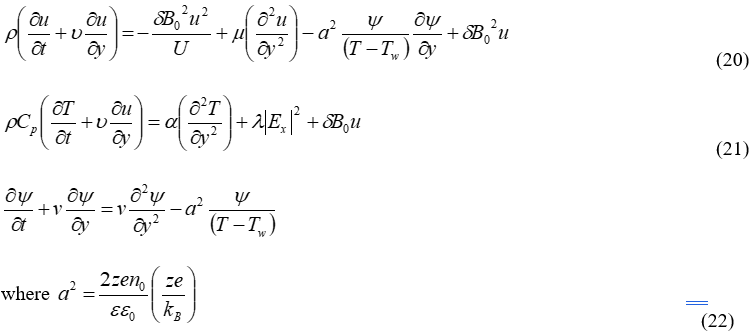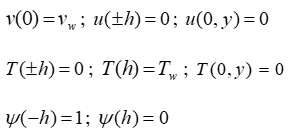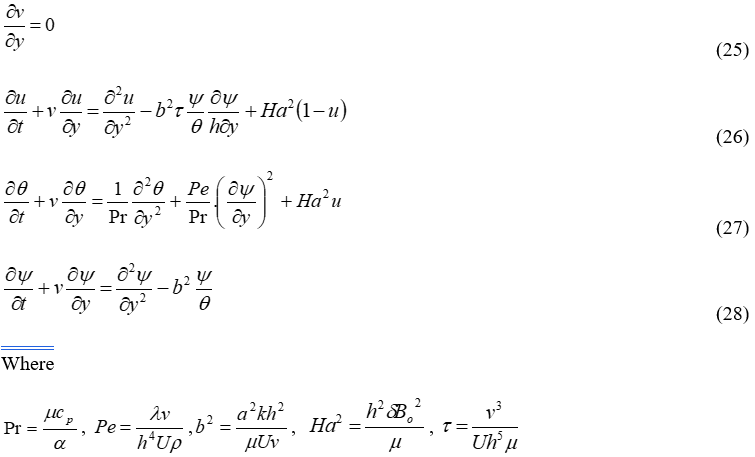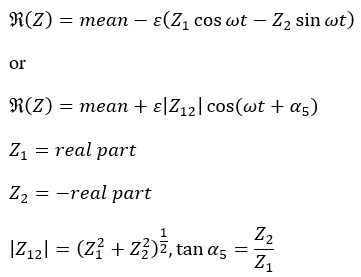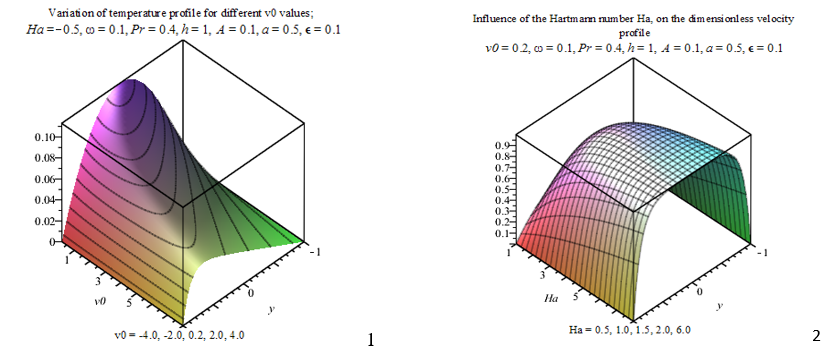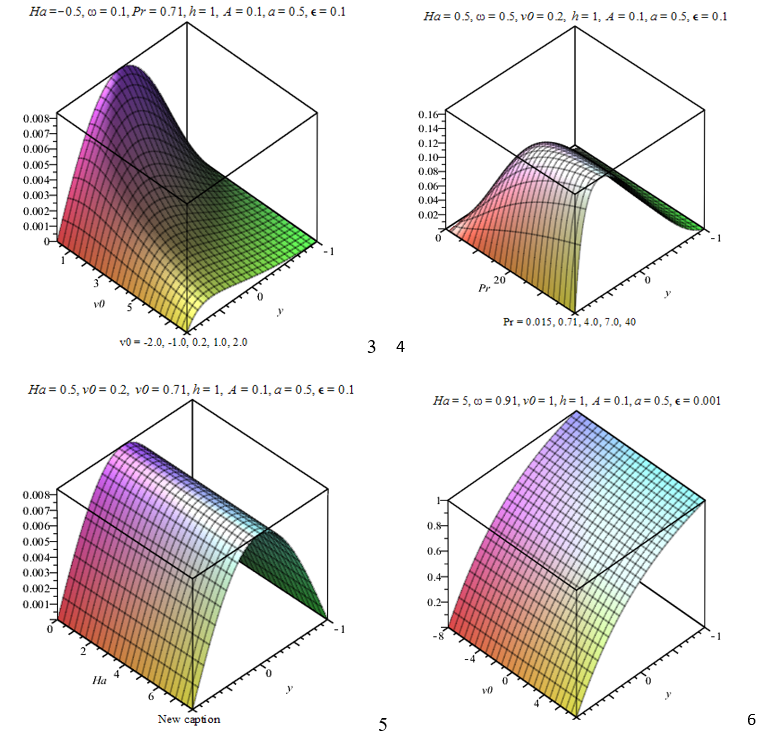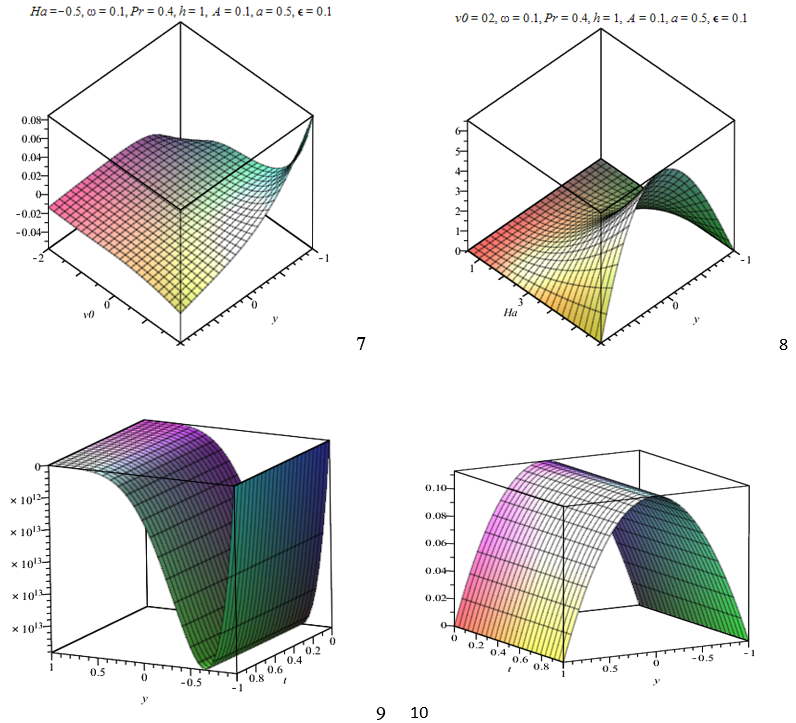Electro-Osmotic Transient Magneto Hydrodynamics Flow and Heat Transfer Analysis in Plane Channel
- Raphael Ehikhuemhen Asibor
- Celestine Friday Osuidia
- Victor Osemudiamhen Asibor
- Felix Moibi Okoro
- 369-383
- Jul 12, 2024
- Mathematics
Electro-Osmotic Transient Magneto Hydrodynamics Flow and Heat Transfer Analysis in Plane Channel
*1Raphael Ehikhuemhen Asibor, 2Celestine Friday Osuidia, 3Victor Osemudiamhen Asibor and 4Felix Moibi Okoro
1Department of Computer Sci. & Mathematics, Igbinedion Univ., Okada Edo State, Nigeria.
2 Delta State Post Primary Education Board, Delta State Asaba, Nigeria.
3Department of Medical Laboratory Science, Igbinedion Univ., Okada Edo State, Nigeria.
4Department of Mathematics, Ambrose Alli University, Ekpoma Edo State, Nigeria.
*Corresponding Author
DOI: https://doi.org/10.51584/IJRIAS.2024.906033
Received: 12 May 2024; Revised: 31 May 2024; Accepted: 14 June 2024; Published: 12 July 2024
ABSTRACT
In this study, we investigate the electro-osmotic transient behavior of magneto hydrodynamics (MHD) flow and heat transfer in a horizontal channel. The flow is driven by an external electric field and subjected to a transverse magnetic field, leading to complex fluid dynamics and heat transfer phenomena. We develop a comprehensive mathematical model based on the governing equations of mass, momentum, energy, and Maxwell’s equations, accounting for the coupled interactions between the electric field, magnetic field, fluid flow, and heat transfer. The numerical solution is obtained using finite volume methods, discretizing the domain into control volumes and employing appropriate boundary conditions. The effects of key parameters such as Hartmann number, Reynolds number, and Péclet number on the flow and heat transfer characteristics are investigated. The results provide insights into the transient behavior of MHD electro-osmotic flow and heat transfer in horizontal channels, with implications for various engineering and biomedical applications.
Keywords: Magneto-hydrodynamics similarity solution, Electro-Osmotic, Newtonian and non –Newtonian flow, porous channel, perturbation technique.
INTRODUCTION
In recent years, the study of electro-osmotic flow (EOF) and its coupled interactions with magneto hydrodynamics (MHD) and heat transfer has attracted significant attention due to its relevance in various engineering and biomedical applications. Electro-osmotic flow refers to the motion of a fluid induced by an applied electric field in a microchannel or porous medium, while magneto hydrodynamics involves the behavior of electrically conducting fluids under the influence of a magnetic field. The combination of these phenomena in a horizontal channel presents a rich area of investigation with implications for micro fluidics, electrokinetics, and thermal management systems.
Understanding the electro-osmotic transient behavior of such systems is crucial for optimizing their performance and enhancing their efficiency. Transient effects arise due to changes in external conditions, such as variations in applied electric or magnetic fields, fluid properties, or channel geometry, and can significantly influence flow patterns, heat transfer rates, and mixing characteristics. Additionally, transient analysis provides insights into the dynamic response of the system to external perturbations, facilitating the design of responsive and adaptive devices. Burgreen and Nakache [4] introduced the study of fluid flow by viewing electrokinetic effects in a very fine capillary micro channel with a rectangular cross-section. They determined the streaming potential and speed with an arbitrarily high ionic energy and small electrokinetic circumstances
In this context, this study aims to investigate the transient behavior of transient magneto hydrodynamics electro-osmotic flow and heat transfer in a horizontal channel. A comprehensive mathematical model is developed based on the fundamental conservation equations governing mass, momentum, energy, and Maxwell’s equations, considering the coupled interactions between the electric field, magnetic field, fluid flow, and heat transfer. Numerical simulations are conducted using advanced computational techniques, such as finite volume methods, to solve the governing equations and obtain detailed insights into the flow and heat transfer phenomena.
The remainder of this paper is organized as follows: Section II presents a detailed mathematical formulation of the problem, including the governing equations, boundary conditions, and solution methods. Section III describes the numerical simulations and validation against analytical solutions or experimental data. Section IV discusses the results and provides insights into the transient behavior of transient magneto hydrodynamics electro-osmotic flow and heat transfer in horizontal channels. Finally, Section V concludes the study and outlines directions for future research
The phenomenon of electro-osmotic magneto hydrodynamic flow with heat transfer has been a subject of great interest in view of its possible applications in many branches of science, technology and also industries. This is due to the fact that these flows have many engineering and geophysical applications such as geothermal reservoirs, drying of porous solids, thermal insulation and enriched oil recovery, groundwater purification and underground energy transportation. In astrophysics and geophysics, it is applied to study the stellar graphics, solar structures, interstellar matter, propagation of radio waves through the ionosphere etc. [13] studied unsteady free convection magneto hydrodynamic flow past a vertical cylinder with heat and mass transfer. [12] considered MHD oscillatory flow on natural convection–radiation through a porous medium with constant suction velocity. [17] examined MHD and radiation effects on moving isothermal vertical plate with variable mass diffusion. [23] considered magneto hydrodynamic unsteady free convection flow past an infinite vertical plate with constant suction and heat sink. [25] studied magneto hydrodynamic free convection flow past an impulsively moving vertical plate with ramped wall temperature in the presence of thermal diffusion with heat absorption. [20] discussed unsteady magneto hydrodynamic free convective flow past a semi-infinite vertical porous plate. [12] considered MHD unsteady free convection flow past a vertical porous plate.
The investigation of flow due to a stretching sheet also has received great attention due to the various industrial applications, such as in the manufacturing of polymer sheets, filaments and wires. During the manufacturing process, the moving sheet is assumed to stretch on its own plane, and the stretched surface interacts with the ambient fluid both mechanically and thermally. Initially, Sakiadis (1961) introduced the concept of a boundary layer flow over a stretching surface. [6] modified the idea introduced by Sakiadis and extended this idea for both linear and exponentially stretching sheets. For example, [18] investigated the stagnation point flow of a viscous fluid towards a stretching sheet and obtained the analytical solution of the boundary layer equation by homotopy analysis method. [5] analyzed magneto-hydrodynamic mixed convective flow and heat transfer of an electrically conducting, of heat generation/absorption and thermal radiation. [2] presented an analytical solution for steady 2D fully-developed flow in channels with rectangular cross sections and different zeta potentials on each wall. For the same geometry, [3] developed a numerical algorithm to conduct parametric studies of the electric potential profiles and the cross-sectional velocity of pure electro-osmotic flow without imposing an external pressure gradient
Electro-osmosis is a basic electrokinetic phenomenon, where the flow of an electrolyte in a channel is induced by an external electric field applied between the inlet and outlet, the principle was first demonstrated by [21] in 1809 in an experiment where it was demonstrated that water could be made to percolate through porous clay diaphragms using the application of an electric field.
The thickness of the electric double layer is on the order of the Debye length, λ, of the solution. The Debye length can then be defined as the distance from the charged wall at which potential energy balances thermal energy, and is typically expressed as the following:

Here, is the permittivity, e is the elementary charge, k is the Boltzmann constant, is the number density of ion species in the bulk, is the valence, and T is the temperature. An understanding of electro-osmosis began with the experiments of Reuss in the 19th century. Reuss discovered that flow through capillary structures could be induced by applying an external electric field. Following this work, Helmholtz proposed the double layer theory that related the electrical and flow parameters for electrokinetic transport in 1879. Subsequently, Smoluchowski expanded Helmholtz’s double layer theory by taking into account the actual distribution in a capillary channel. A more realistic concept of the potential and charge distribution in the fluid adjacent to the capillary wall was introduced by Gouy in 1910. Debye and Huckel determined the ionic number concentration in a solution of low ionic energy, by means of a linear simplification of the exponential Boltzmann ion energy distribution. [4] conducted an analytical study of electrokinetic flow in ultra-fine channels with rectangular cross sections. [22] theoretically studied the electrokinetic flow in narrow cylindrical capillaries.
Poisson–Boltzmann equation
To express the body force, Poisson–Boltzmann equation and Debye–Huckel approximation is needed. The Poisson–Boltzmann equation is related to the potential distribution within the EDL. This can be expressed in y-direction as follows:

Where the electrical potential, ∈ is the dielectric constant or the permittivity of fluid and is the net electric charge density equation (2) is the Poisson equation. Assuming that the equilibrium Boltzmann equation is applicable which implies uniform dielectric constant, the number concentration of type-i ions are of the form

Where and are the bulk ionic concentration, valance of type-I ions. Elementary charge, Boltzmann constant and absolute temperature, respectively. The net electric charge density can be expressed assuming a symmetric electrolyte as follows:

substituting equation (4) into Equation (2), yields to the Poisson–Boltzmann equation

The Debye-Huckel linear approximation yields 

This linear approximation is valid when the electrical potential is small compared to the thermal energy of the ions and equation (29) can be written as . where
is the Debye-Huckel parameter and 1/k is the Debye length. It is the characteristic thickness of the EDL.
RESEARCH METHODS
The geometry under consideration is shown schematically in figure. 2, where a microchannel is formed between two parallel plates separated by a distance (height) 2H. The length of the channel is while the width is assumed to much larger than the height, H, i.e., w >> 2H . The bottom plate is located at y = –H while the top plate is located at y = +H. A potential is applied along the axis of the channel which provides the necessary driving force for the flow. Due to the symmetry of the geometry with respect to the channel axis, only one half of the channel (0 ≤ y ≤ H) is considered for the analysis.
In this diagram:
- The rectangular box represents the microchannel.
- The arrows indicate the direction of fluid flow, driven by an applied electric field.
- The “Electrical Inlet” and “Electrical Outlet” represent the points where the electric field is applied or where electrodes are located.
- The length and width of the microchannel can vary depending on the specific geometry of the system.
This simplified schematic provides a visual representation of the microchannel geometry for electro-osmotic flow is shown below.
Figure. 1: Schematic diagram of the micro channel geometry for the electro-osmotic flow of fluids considered in this study.
In this paper, we consider a two-dimensional steady, laminar and incompressible flow is governed by the following equations and are determined by knowledge of velocities, pressure, density, viscosity, specific heat and temperature. Micro fluidics has become a more attractive research area nowadays. The major area of application is the miniaturization of the transport device, biotechnology, micro electro- mechanical system (MEMS), and drug delivery chip [27–32].
The continuity (mass conservation) Equation:
The equations describing the velocity field, u and v, of the fluid phase with density being constant, is describe in its general form as

x-momentum equation;

energy (transport) equation;

and
The Poisson Boltzmann equation

A unidirectional, steady state, incompressible, fully developed flow of the Newtonian fluid is assumed in the slit microchannel. The flow field is generated because of the electroosmotic effect. No-slip velocity and constant temperature is assumed on the walls of the microchannel. In this study, h is the half-height of the slit microchannel. u and p represent velocity and pressure, respectively. T is temperature; Ex stands for external electric field; denotes the electric potential of the electric double layer (EDL). μ and are the viscosity and density of the fluid; c and k are the specific heat capacity and thermal conductivity of the fluid. and are the relative and absolute permittivity. z is the valence of the ion, e is the elementary charge, kb is Boltzmann constant and is the ionic bulk number concentration.
Thus

and equation 8 reduces to

since the flow property is assumed uniform along the channel, the axial acceleration will be zero that is,

Then

the stable Boltzmann distribution of ions in the electric double layer can be assumed, that according to Bruus is given by

where no = CNA is the bulk number concentration of ions in the electrolyte solution, C is the molar concentration of ions, NA is Avogadro’s number, T is the temperature and kB is the Boltzmann constant. For small values of , synonymous of a small ratio of electrical to thermal energies, equation (9) can also be linearized, sinh(x) ≈ x, using the Debye-Hückel approximation. Then, the electric charge density equation, becomes
(16)
where,

is the Debye-Hückel constant, related to the thickness of the Debye layer, (also referred to as the EDL thickness).
Finally, we can rewrite the Cauchy equation (8) as,


The mathematical model of this paper is
the corresponding boundary conditions are
Non-dimensional of the equation
By use of the following non-dimensional quantities.
and on comparing and substituting, we get
upon further substitution and simplification, equations (19 – 22) becomes
stands for Prandtyl number, Electrical Prandtl number, Modified Debby-Hucket number, Hartmann number, asibor constant representltly
Method of Solution
To solve equations (25 – 28) with the initial boundary conditions stated above, we use perturbation in the neighborhood of the limiting surface, similar to the one used by Lighthill (1954). The Velocity, induced magnetic and temperature fields are given by the expressions
Substituting equation (29 – 32) into equations (25 – 28)
with boundary conditions
(36)
(37)
The functions u0 (y),θ0 (y) and ψ0 (y) are the mean velocity, the mean temperature and mean species distribution fields respectively, and u1 (y),θ1 (y) and ψ1 (y) are the oscillatory part of the velocity, the oscillatory part of the temperature and the oscillatory part of the concentration fields respectively.
Validation of Results
The velocity is decomposed into the mean part, the harmonic part and the mean particle. The one that is not affected by its oscillatory while the harmonic part is the oscillatory part
The harmonic part
velocity harmonic part

temperature harmonic part,

concentration harmonic part

The non-harmonic part gives
velocity non-harmonic part gives

temperature non-harmonic part

and concentration non-harmonic part

equations 38 – 43 are the perturbed equation in ordinary differential equations form, and they are solved using the method of undetermined coefficients.
We consider the below for mean Velocity, Temperature and Concentration
where
we then express each of velocity, temperature and concentration as
(47)
where
For the above, ϕ represent u,θ and ψ, ϕi (i=1,2) is the fluctuating part of u,θ and ψ respectively, |ϕ12 | and tan αϕ define above means Amplitude and Phase angle respectively for u,θ and ψ.
The last section of the computation shall be for skin friction as
In terms of amplitude and phase of the skin friction, we have from (52)
Also since we know the temperature distribution, we then calculate the expression for the wall temperature (Nusselt number) written as
In terms of amplitude and phase of the skin friction, we have from
The rate of mass transfer at the wall which is the ratio of length scale to the diffusive boundary layer thickness is given by
which implies
and in terms of amplitude and phase of electric current density, we have
We will also obtain mean, transient, fluctuating part, Amplitude and phase angle for skin friction, wall temperature and concentration graphs.
The graphs are drawn and displayed below
Mean Velocity distributions for various values of suction parameter
Mean Temperature distributions for various values of suction parameter
Mean Concentration distributions for various values of Hartmann number
CONCLUSION
In this study, we have investigated the transient behavior of transient magneto hydrodynamics electro-osmotic flow and heat transfer in a horizontal channel. Through a comprehensive mathematical formulation and numerical simulations, we have gained valuable insights into the complex interplay between electric fields, magnetic fields, fluid flow, and heat transfer phenomena.
Our analysis has revealed several key findings:
- Transient Effects: Transient phenomena play a significant role in the behavior of electro-osmotic flow and heat transfer in horizontal channels. Time-dependent variations in applied electric or magnetic fields, as well as changes in fluid properties and channel geometry, can lead to dynamic flow patterns, temperature distributions, and heat transfer rates.
- Coupled Interactions: The coupling between electro-osmotic flow, magneto hydrodynamics, and heat transfer introduces intricate interactions that influence the overall system behavior. Electric fields induce fluid motion, which, in turn, affects the distribution of magnetic fields and temperature gradients in the channel.
- Parameter Sensitivity: The behavior of the system is sensitive to various parameters, including the Hartmann number, Reynolds number, Péclet number, and channel geometry. Small changes in these parameters can have significant effects on flow velocities, temperature profiles, and heat transfer rates.
- Engineering Implications: The insights gained from this study have implications for the design and optimization of microfluidic devices, electrokinetic systems, and thermal management systems. Understanding the transient behavior of these systems is essential for improving their efficiency, reliability, and performance.
In conclusion, our study provides a comprehensive understanding of electro-osmotic transient magneto hydrodynamics flow and heat transfer in horizontal channels. By elucidating the complex interactions between electric fields, magnetic fields, fluid flow, and heat transfer, we contribute to the advancement of knowledge in this field and pave the way for future research and innovation in related applications. We studied analytically transient (unsteady) Magneto hydrodynamics Electro-Osmotic Flow and Heat Transfer Analysis in Horizontal Channel for unsteady laminar incompressible flow in the presence of electroosmotic force under slip boundary conditions. The governing boundary layer equations of the physical situations are solved employing Perturbation method. The results of velocity, temperature concentration, skin friction and Nusselt number under the influence of various material parameters are showed on the figures above. Figures 1 – 2 represent the mean velocity distributions for various values of Hartmann number, figures 3 – 6 represents the mean temperature distributions for various values of Hartmann number and figures7 -10 shows the mean Concentration distributions for various values of Hartmann number
REFERENCES
- Alfven Hannes, (1946). On the cosmogony of the solar system III. Stockholms Observatorimms Annaler, vol 14, pp. 9. 1-9.29
- Andreev, V. P., Dubrovsky, S. G. and Stepanov, Y. V. (1997), Mathematical modeling of capillary electrophoresis in rectangular channels J. Microcolumn Sep. 9 443
- Arulanandam, A. and Li, D. (2000), Liquid transport in rectangular microchannels by electroosmotic pumping Colloids Surf. A 161 pp. 89–102
- Burgreen, D. and Nakache, F. R. (1964), Electrokinetic flow in ultra-fine capillary slits J. Phys. Chem. 68 pp. 1084–1091
- Chen, C. H. (2009), Int. J. Nonlinear Mech. 44, 596
- Crane, L. and Zeit. Angew., (1970), Math. Phys. 21, 645
- Debye P and Huckel E (1923), Zur Theorie der Elektrolyte I Physik. Z. 24 pp. 185–206
- Debye P and Huckel E (1923), Zur Theorie der Elektrolyte II Physik. Z. 24 pp. 305– 324
- Dose, E. V. and Guiochon, G. J., (1993), Chromatogr. 652, pp. 263-275.
- Dutta, P. and Beskok, A. (2001), “Analytical Solotion of combined electroosmotic/Pressure driven Flows in two-dimensional straight channels: finite Debye layer effects”. Anal. 73, pp.1979- 1986
- Dutta, P. and Beskok, A. (2001), Analytical solution of time periodic electroosmotic flows: analogies to Stokes’ second problem Anal. Chem. 73 pp. 5097–102
- El-Hakiem, M. A., (2000), MHD oscillatory flow on free convection–radiation through a porous medium with constant suction velocity, J Magn Magn Mater, Volume 220, 271–276,
- Ganesan, P. G., Rani, P. H., (2000), Unsteady free convection MHD flow past a vertical cylinder heat and mass transfer. Int Journal Therm Sci, Volume 39, 265–272.
- Gouy, G. (1910) Sur la constitution de la charge ´electrique `a la surface d’un electrolyte J.Phys. 9 pp. 457–468
- Hartmann, J., (1937), Theory of the laminar flow of an electrically conductive liquid in a homogeneous magnetic field, Math. Fys. Med., 15, pp. 1-27.
- Helmy, K. A., (1998), MHD unsteady free convection flow past a vertical porous plate, ZAMM, Volume 78, 255-270,
- Muthucumaraswamy, R., Janakiraman, B., (2006)., MHD and radiation effects on moving isothermal vertical plate with variable mass diffusion, Appl. Mech, Volume 33, 17–29,
- Nadeem, S., Hussain, A, (2010), Commun. Nonlinear Sci. Numer. Simul. 15, 475
- Patankar, N. A. and Hu, H. H. (1998), Anal. Chem. 70, pp. 1870-1881.
- Rajasekhar, K., Ramana Reddy, G. V., (2012), BDCN Prasad, Unsteady MHD free convective flow past a semi-infinite vertical porous plate, Int Jou Mod Eng Res, Volume 2(5), 3123–7,
- Reuss, F. F. (1809), Sur un nouvel effet de l’´electricit´e glavanique M´emoires de la Societ´e Imperiale des Naturalistes de Moscou 2 pp. 327– 337
- Rice C. L. and Whitehead, R. (1965), Electrokinetic flow in a narrow cylindrical capillary J.Phys. Chem. 69 4017–24
- Sahoo, P. K., Dutta, N., and Biswal, S., (2003), Magnetohydrodynamic unsteady free convection flow past an infinite vertical plate with constant suction and heat sink, Indian J. pure and applied Mathematics, Volume 34(1), 145-155,
- Santiago, J. G., (2001), Electroosmotic Flows in Microchannels with Finite Inertial and Pressure Forces, Chem. 73, pp. 2353-2365
- Seth, G. S., and Ansari, Md. S., (2010), MHD natural convection flow past an impulsively moving vertical plate with ramped wall temperature in the presence of thermal diffusion with heat absorption, Jou. Appl. Mech. Eng., Volume 15, 199–215,
- Yang, R. J., Fu, L. M. and Hwang, C. C. (2001), Electroosmotic entry flow in a microchannel J. Colloid Interface Sci. 244 173–79
- Balaram Kundu and Sujit Saha. Review and Analysis of Electro Magnetohydrodynamic Flow and Heat Transport in Microchannels Energies 2022, 15, 7017. https://doi.org/10.3390/en15197017 mdpi. com/journal/energies
- Becker, H.; Gärtner, C. Polymer microfabrication methods for microfluidic analytical applications. Electrophoresis 2000, 21, 12–26.
- Gravesen, P.; Branebjerg, J.A.; Jensen, O.S. Microfluidics-a review. J. Micromechanics Microengineering 1993, 3, 168–182.
- Nguyen, N.-T.; Wu, Z. Micromixers—A review. J. Micromech. Microeng. 2004, 15, R1–R16.
- Ohno, K.-I.; Tachikawa, K.; Manz, A. Microfluidics: Applications for analytical purposes in chemistry and biochemistry. Electrophoresis 2008, 29, 4443–4453.
- Ziaie, B.; Baldi, A.; Lei, M.; Gu, Y.; Siegel, R.A. Hard and soft micromachining for BioMEMS: Review of techniques and examples of applications in microfluidics and drug delivery. Adv. Drug Deliv. Rev. 2004, 56, 145–172.



